Accrington Corporation Tramways
History
Accrington Corporation acquired powers to build a 5.7-mile tramway system on the 12th July 1882, under the Accrington Corporation Tramways Act, 1882.
Construction of the 4ft 0ins-gauge steam tramway did not start until 1884, and was plagued by problems from the outset, with allegations of corruption in the choice of the contractor, who then ran out of money, all ending in the corporation having to complete the system itself, for which it appears to have lacked the requisite skills. The track was not only badly laid, but was also of a design — the Barker rail — that was to prove itself fundamentally unsuited to the use of steam tram engines. As municipal authorities were prevented from operating tramways by the Tramways Act of 1870, this was to have serious consequences for the eventual lessee (operator).
After struggling to find a lessee, an agreement was finally signed on the 29th October 1885, with Messrs Cash and Company of London, who then set up a new company — the Accrington Corporation Steam Tramways Company (see link) — to operate the tramway; the ACSTCo was incorporated on the 12th December 1885.
Public steam services commenced on the 8th April 1886 between Church, Accrington Market Place and Clayton-le-Moors, the rest of the system, between Accrington Market Place and Baxenden, opening two months later on the 12th June 1886. As the enabling act only allowed two years for construction from the date of Royal Assent (12th July 1882), some kind of dispensation must have been sought to extend the time allowed.
The services were operated by the ACSTCo under a 21-year lease that commenced on the 5th April 1886, and which was set to expire on the 12th April 1907.
Although the ACSTCo subsequently extended the tramway (in 1887) beyond Accrington, through Haslingden to Rawtenstall, this was not owned by Accrington Corporation, but by the company.
The corporation-owned steam tramway comprised 5.5 miles of tramway. From Accrington Market Place, lines ran: westwards along Blackburn Road to a terminus outside the Commercial Hotel in Church; northwards along Whalley Road to a terminus outside the Load of Mischief Inn in Clayton-le-Moors, which was around 300 yards short of the authorised length; and southeastwards along Manchester Road to Baxenden, the line beyond being owned by the company. Although the corporation system was connected to the 4ft 0in-gauge tracks of Blackburn Corporation Tramways at Church, other than the odd special working, no regular through running took place.
Unfortunately for the ACSTCo (and its shareholders), the Accrington lease included responsibility for the track, which was to cause serious problems for the company, which not only had to spend significant sums as the track rapidly deteriorated, but had also to deal with the deleterious effect on its engines. The expense incurred in dealing with the rail problem, as well as severe downturns in the cotton trade and an unenviable accident record, led to low or no dividends for the best part of a decade. The company's own lines were laid with much more robust girder rails, so did not give rise to the same issues.
The tramway did eventually pay its way, and by 1899 it had attracted the attention of the British Electric Traction Company. At this time, the BETCo was aggressively purchasing horse and steam-operated tramways across the British Isles with the intention of converting them to electric traction, as well as promoting schemes for completely new electric tramways. Although agreement on the terms of a sale was reached between the ACSTCo and the BETCo, the latter's interest waned when it became clear that Accrington Corporation was set upon converting its own lines to electric traction and operating them itself.
Although the company subsequently attempted to sell the tramway (the goodwill, engines and trailers, etc.) to the corporation, the latter chose to wait until the lease expired — in April 1907 — no doubt to ensure that they got the best deal possible. The down side of this was that conversion to electric traction came rather late in the day compared with nearby Blackburn and Darwen, though Haslingden and Rawtenstall were later still, the latter becoming the last street tramway system in Britain to use steam traction on a regular basis.
The corporation planned well ahead, obtaining powers on the 30th June 1905 — under the Accrington Corporation Act, 1905 — to convert the tramway to overhead electric traction, as well as to build extensions to it. The extensions were relatively modest, comprising lines out to Oswaldtwistle and to the town cemetery (near Huncoat), and a short extension of the existing Clayton-le-Moors line.
Despite holding these powers for nearly two years, the corporation was still not ready to take over operation of the system when the lease expired (12th April 1907), so the ACSTCo agreed to continue working the steam services within Accrington until such time as the corporation was ready.
The first corporation electric service — between Accrington town centre and Oswaldtwistle, via Church — commenced on the 2nd August 1907. The tracks at Church were connected to those of Blackburn Corporation Tramways, the BCT commencing a through service between Blackburn and Accrington the same month. The lines to Clayton-le-Moors and along Burnley Road to the cemetery, were opened on the 20th September and the 26th October, respectively.
Meanwhile, and following arbitration, a price had been agreed for a proportion of the assets of the ACSTCo, i.e., those pertinent to the operation of services within Accrington. The corporation formally purchased the engines, trailers and assets necessary to work its lines on the 20th September 1907, with the ACSTCo agreeing to continue working the steam services until the end of the year on a contract basis. The last steam tram in Accrington duly ran on the 31st December 1907, electric services to Baxenden (on the Accrington-Haslingden boundary) commencing the following day. On the same day (the 1st January 1908), Haslingden and Rawtenstall Corporations took over the former ACSTCo lines within their respective boroughs, as well as an agreed proportion of the ACSTCo's engines and trailers, with Haslingden Corporation providing the steam services for both corporations thereafter.
Although the 31st December 1907 was the last official steam service, there is some circumstantial evidence to suggest that Haslingden Corporation may have run a service through to Accrington as late as the 4th or 5th of September 1908, though probably just to celebrate the end of the steam working, or at least the end of steam working on the Haslingden-Baxenden route.
The first electric services over Haslingden Corporation-owned track (from Baxenden to the Commercial Hotel in Haslingden), which commenced on the 5th September 1908, and which were subsequently extended through to Lockgate (the boundary between Haslingden and Rawtenstall), were operated by Accrington Corporation Tramways under a lease agreement.
Accrington's 4ft 0ins-gauge overhead electric system was never extended, comprising just over 7 miles of tramway. From Accrington Market Place, lines ran: westwards along Blackburn Road to Church, then southwards along Market Street and Union Road to a terminus outside the Black Dog at New Lane; northwards along Whalley Road to a terminus in Clayton-le-Moors just short of the Leeds and Liverpool Canal bridge; and southeastwards along Manchester Road to Baxenden Station (the boundary with Haslingden). A line also ran eastwards from Whalley Road along Burnley Road to the cemetery at Hillock Vale; although this was sometimes referred to as the Huncoat line, it actually terminated some distance short of the village of that name. The corporation also worked the 2.9-mile Haslingden Corporation system, which was connected to Accrington's system at Baxendale, and Rawtenstall Corporation's system at Lockgate.
Through-running agreements were implemented with both Blackburn and Rawtenstall Corporations. From August 1907, BCT cars ran through to Accrington, with ACT cars eventually joining in, i.e., running through to Blackburn, a decade later, from the 1st February 1917. From the 1st April 1910, RCT cars ran through to Accrington and ACT cars ran through to Bacup, though the latter was cut back to Rawtenstall in 1917.
By 1912, the tramway services were being operated by 27 cars, a number of which were single-deckers, which were necessary for operation of the Oswaldtwistle line, due to a low bridge. Eighteen cars were acquired in 1907, two in 1908, three in 1909, two in 1901, and two in 1912. Five more were ordered in 1914, but due to the outbreak of the Great War, were not delivered until 1919. The exigencies of the Great War — loss of men and their skills to the armed services, heavy use on poorly maintained track, and a lack of spares and materials — no doubt took a heavy toll on the system, though the department did manage to obtain a significant amount of track in 1917, which it bought together with several other neighbouring systems (it is unclear where from). One casuality of the war was the through service to Bacup, which was cut back to Rawtenstall on the 1st January 1917 as an economy measure, but which was never reinstated.
The system received a boost in 1919 with the delivery of the five tramcars ordered in 1914, which were followed eight years later (in 1926) by the final two new cars.
By 1922, bus competition was making itself felt, though the system was spared the worst excesses of unfettered competition by judicious licensing, which not only ensured that protective fares were in place (higher than those charged by the tramway), but which also prevented the bus companies from carrying passengers along the tramway routes who were travelling solely within the borough. Although the corporation made a half-hearted effort to obtain powers to run its own motorbuses, it wasn't until 1928 that they were acquired, by which time the choicest routes were already taken by the bus operators. The powers, which were acquired on the 3rd August 1928 under the Accrington Corporation Act, 1928, not only authorised the corporation to run motorbuses, but also trolleybuses, though the latter powers were never exercised.
The corporation introduced its first motorbus services on the 12th of November 1928, these being quickly followed by an express service between Accrington and Bacup, which commenced on the 3rd December 1928; this was jointly operated by Accrington, Haslingden and Rawtenstall Corporations. The tramway route between the towns was to some extent protected, both by the fares, and by the limited number of stops. This was followed, in 1929, by a similar service between Accrington and Blackburn.
In May 1929, however, Rawtenstall announced its intention to abandon its tramway system in favour of motorbus services, which was followed up — on the 1st July 1929 — by an agreement between Acrrington, Haslingden and Rawtenstall Corporations to abandon the tramway line between Rawtenstall and Accrington on the 31st March 1930, and replace the services with motorbuses. The situation now changed rapidly, the corporation also deciding to replace the Oswaldtwistle line with buses following discussions with Oswaldtwistle Council over extensive roadworks in Union Road that would have prevented tramway operation. The date for abandonment of the line was set for the 1st August 1931.
The writing was now clearly on the wall for the tramway, as without the Accrington-Rawtenstall, and Accrington-Oswaldtwistle lines, the rest of the system could not realistically be operated economically. Motorbuses duly took over from the trams (between Rawtenstall and Accrington on the 1st April 1930, the Clayton-le-Moors and Oswaldtwistle lines closing on the 26th August 1931; as the latter included the line out to Church, this also put an end to BCT through running. Ironically, this left the Blackburn Road line, which had always struggled to make a profit, and would almost certainly have been closed at the same time if sufficient buses had been available. In the event, the trams struggled on, interspersed with buses, the last tram of all running on the 6th of January 1932.
Uniforms
Staff working the newly inaugurated electric services were provided with double-breasted, lancer-style tunics with five pairs of buttons (narrowing from top to bottom) and stand-up collars; the latter bore system initials ('A C T') on the bearer's right-hand side, and and an employee number on left-hand side. The tensioned-crown peaked caps bore standard, off-the -shelf, script-lettering grade badges, either 'Driver' or 'Conductor'; these were almost certainly made in nickel to match the buttons.
Tramcar crews were also issued with long, double-breasted greatcoats with five pairs of buttons and high, fold-over collars; the latter carried individual nickel system initials ('A C T') on both sides.
Inspectors were provided with typical single-breasted 'tramway inspector' jackets with hidden buttons (or more likely, hook and eye fasteners), all edged in a finer material than the main jacket, and with stand-up collars. The latter certainly bore insignia, though surviving photographs are unfortunately not of sufficient quality to discern what these were. Caps were initially of the drooping-peak type, which were eventually displaced by tensioned-crown peaked caps, the glossy peaks of which were embellished with braiding. Although the caps almost certainly bore a badge — more than likely the grade embroidered in script lettering — photographic evidence that would confirm this is so far yet to surface.
In common with the vast majority of UK tramway operators, Accrington employed the services of women during the Great War, both as conductresses (from 1915) and later on (1917) as motorwomen. Just a solitary photograph appears to have survived, which unfortunately only shows a conductress from a distance; the subject is wearing a single-breasted, tailored jacket with four pockets (the top two with button closures), a waist belt and lapels, and a long, matching skirt. It is currently unclear what insignia, if any, were carried on the jacket. Headgear appears to have taken the form of a close-fitting bonnet, possibly brimless.
Further reading
For more information on the system, see: 'The Tramways of Accrington 1886-1932' by R W Rush; The Light Railway Transport League (1961).
Images
Motormen and conductors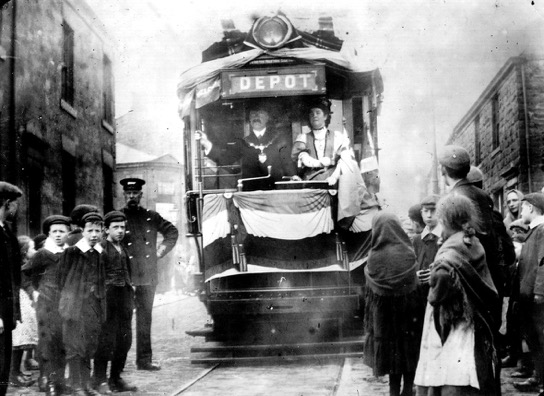
One of the ACT's new single-deck trams (Nos 1 to 4), decorated for the opening procession, which actually took place the day after the line was certified for use, i.e., on the 2nd August 1907. The motorman stands proprietorially to one side, whilst the Mayor and Mayoress pose for the cameraman on the platform.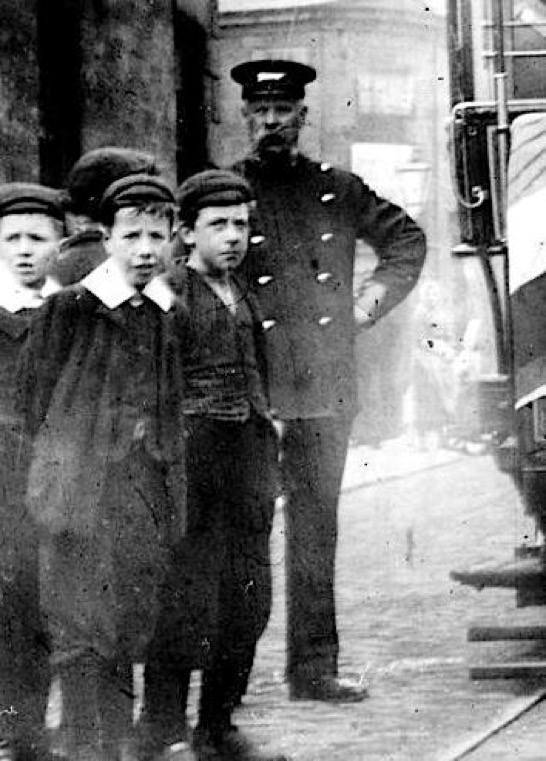
An enlargement of the above photograph showing the motorman. He is wearing a double-breasted, lancer-style tunic and a tensioned-crown peaked cap bearing a script-lettering 'Driver' grade badge.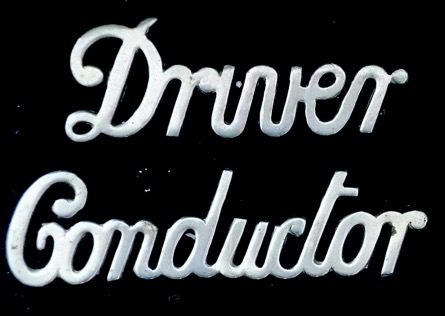
General pattern script-lettering cap badges — 'Driver' and 'Conductor' — of the pattern used by the ACT; nickel. Author's Collection.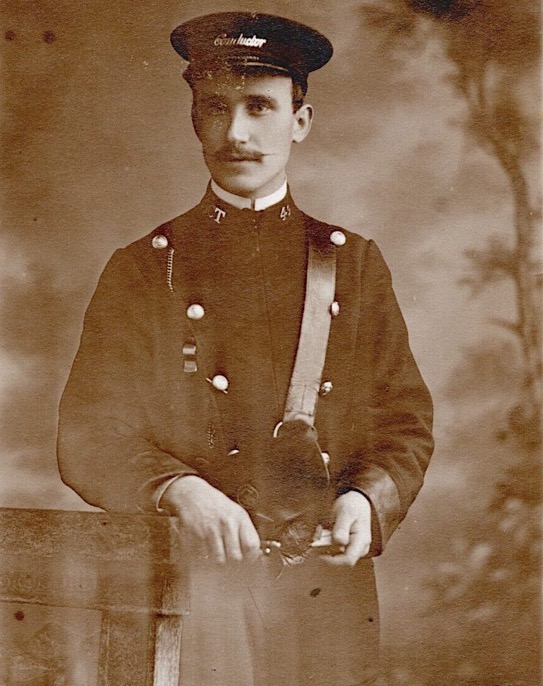
A studio portrait of an Accrington Corporation Tramways conductor, Employee No 49 — photo undated, but probably late-Edwardian era. The photograph clearly shows that individual system initials were carried on the bearer's right-hand collar, and an employee number on the left.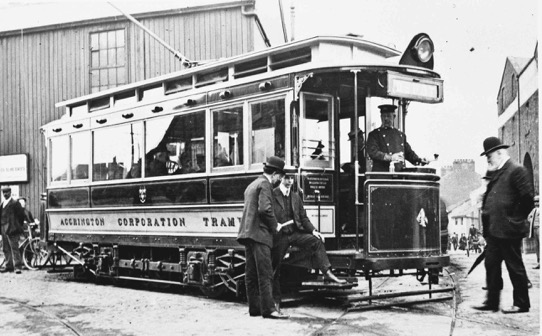
Tramcar No 4 pictured turning from Market Street in Church into Blackburn Road, with the link to Blackburn Corporation's Church line in the background — photo undated, but judging by the immaculate condition of the vehicle, almost certainly taken in August 1907. With thanks to the National Tramway Museum. 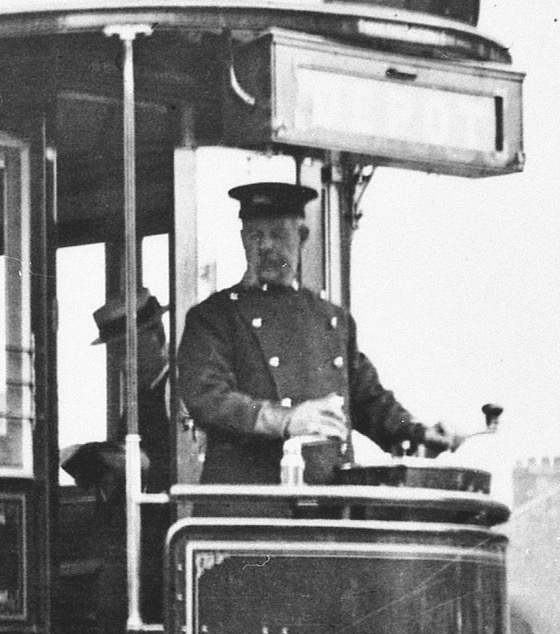
An enlargement of the above photograph showing the motorman, who would appear to be the same individual pictured in the opening day procession photograph above. He is wearing a lancer-style tunic with stand-up collars and a tensioned-crown peaked cap.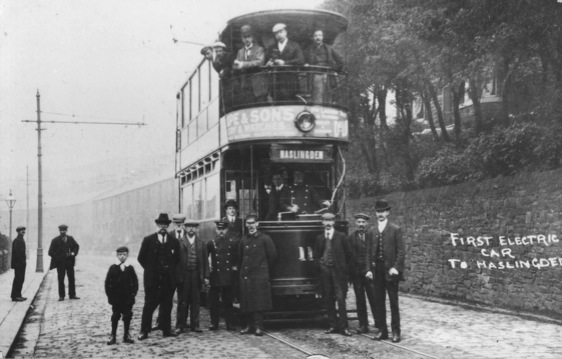
A local postcard, ostensibly commemorating the first electric tramcar (No 11) to Haslingden, which took place on the 28th September 1908. Photo courtesy of Jim Halsall.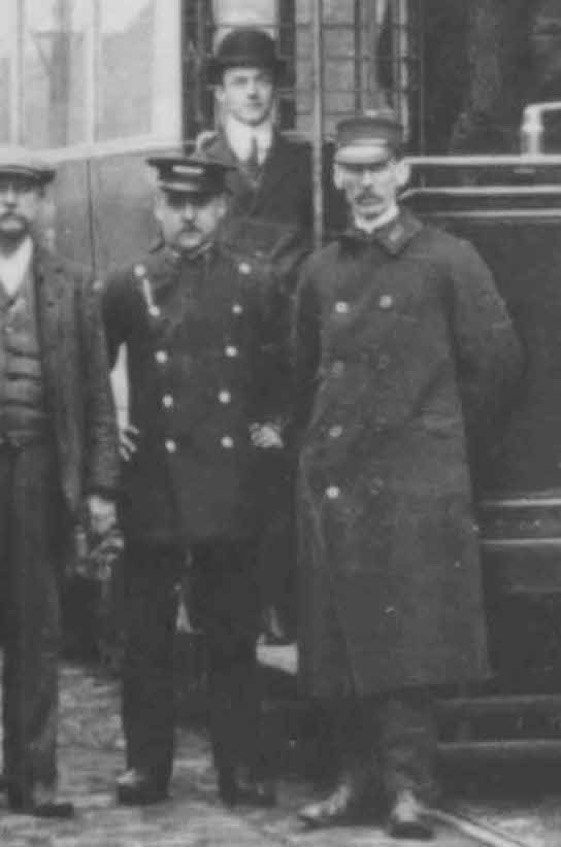
An enlargement of the above photograph, which though of low resolution, does show some details of the conductor's (middle) and inspector's (right) uniforms.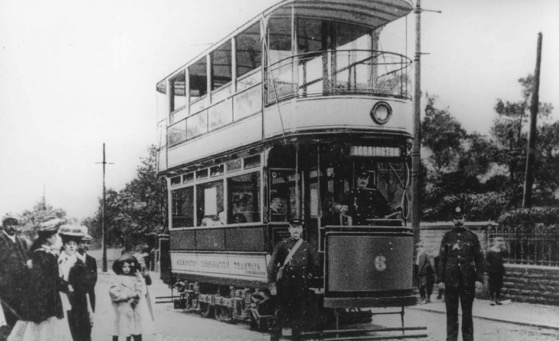
The crew of Tramcar No 6 pose for the camera at Oakleigh, Whalley Road — photo undated, but given that the vehicle looks to be in very good condition, probably taken in late 1908 when No 6 was delivered. Author's Collection.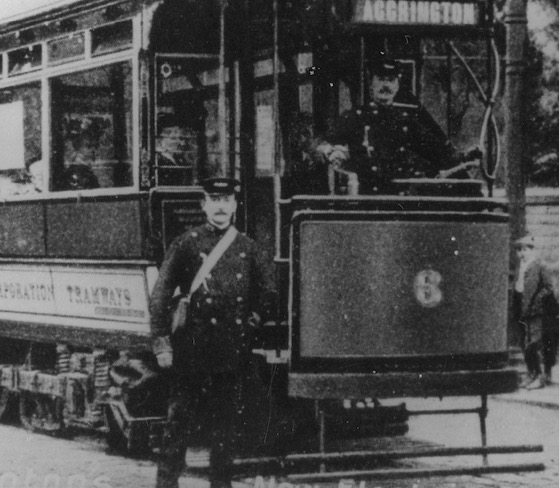
An enlargement of the above photograph, which though of poor quality, shows both men wearing lancer-style tunics and tensioned-crown peaked caps bearing script-lettering grade badges.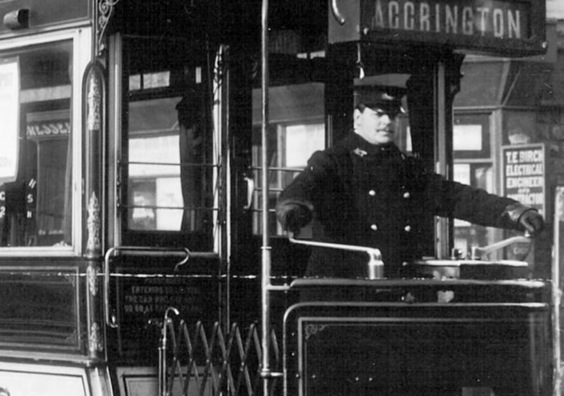
A motorman at the controls of Tramcar No 5, believed to have been taken in the vicinity of China and India Streets around 1910. The subject is wearing a 'Driver' script-lettering cap badge, and 'A C T' system initials on his greatcoat collar. Photo courtesy of Duncan Holden.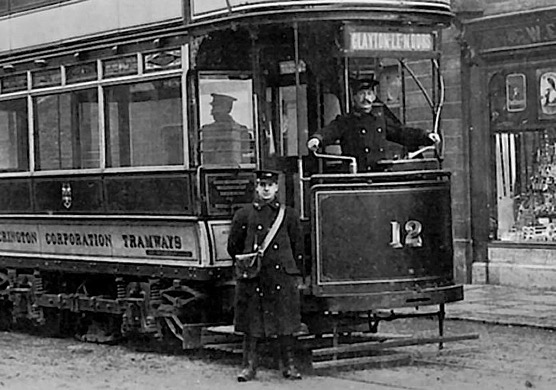
A Clayton-bound Tramcar No 12 and crew — photo undated, but probably late Edwardian. Although difficult to make out, both men are wearing greatcoats with 'A C T' system initials on both collars. Photo courtesy of Duncan Holden.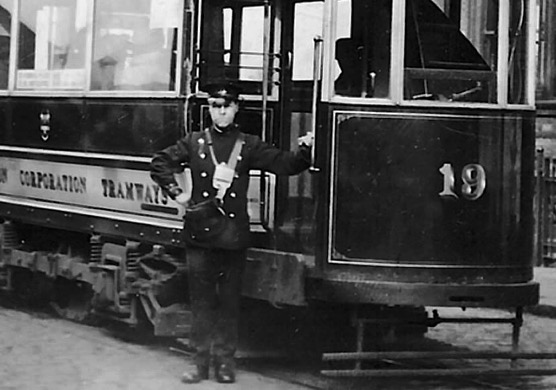
A conductor poses for the photographer with Tramcar No 19 — photo undated, but probably taken in the 1920s. Photo courtesy of Duncan Holden.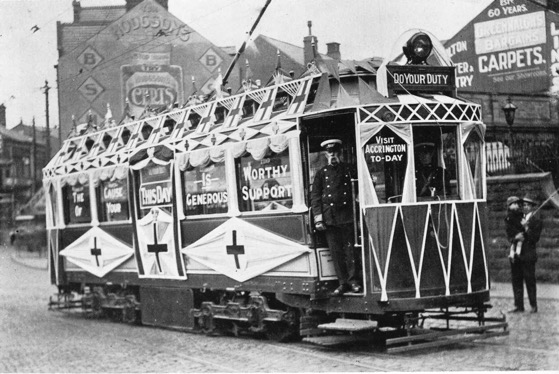
A motorman and a conductor with a tram decorated to help raise funds for an extension of Victoria Hospital — August 1926. Photo courtesy of the Tramways and Light Railway Society, with thanks to David Voice.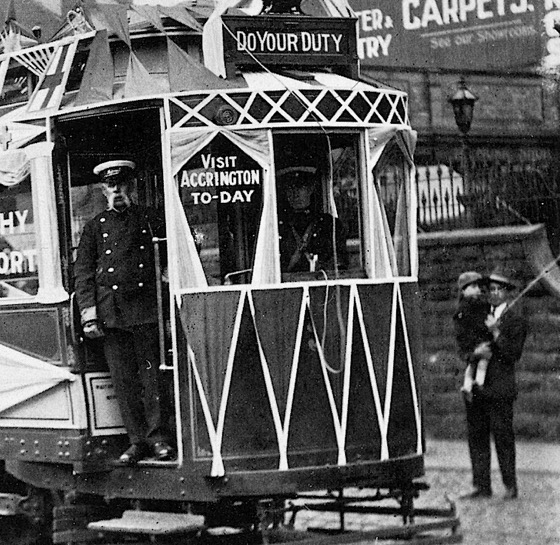
An enlargement of the above photograph showing the crew, whose uniforms are unchanged, stylistically, from those provided at the commencement of services in 1907.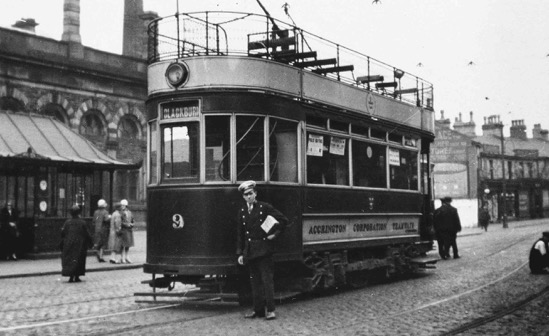
A motorman stands with Tramcar No 9 in Peel Street in the centre of Accrington — photo undated, but probably taken in the early 1920s given that No 9 was refitted with its original roofed upper deck in 1924. Photo believed to have been taken by Walter Gratwicke, with thanks to the National Tramway Museum. 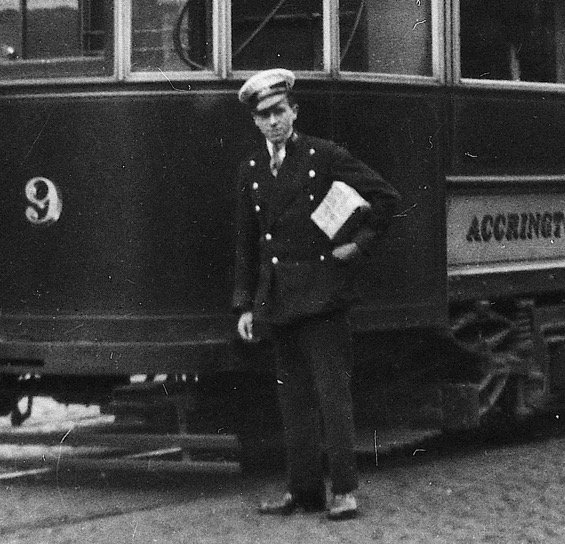
An enlargement of the above photograph showing the motorman. Although on first glance he appears to be wearing a jacket with lapels, it is in fact a standard lancer-style tunic, half unbuttoned. With thanks to the National Tramway Museum. 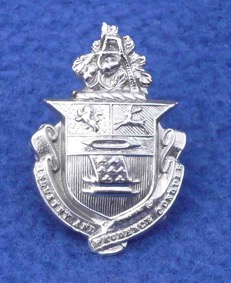
An Accrington municipal-device badge — chrome. There is no evidence to suggest that this badge was ever worn during the tramway era.
Senior staff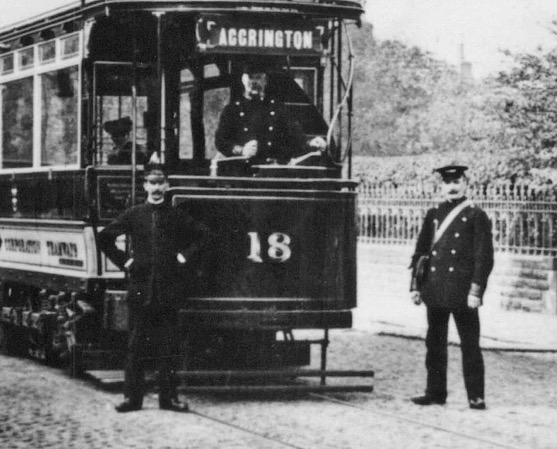
An inspector (left) poses for the camera with the crew of Tramcar No 18 at Oakleigh, Whalley Road — photo undated, but given the pristine condition of the tram, very probably taken in late 1907. In contrast to the crew, the inspector is wearing a drooping-peak cap. Photo courtesy of Jim Halsall.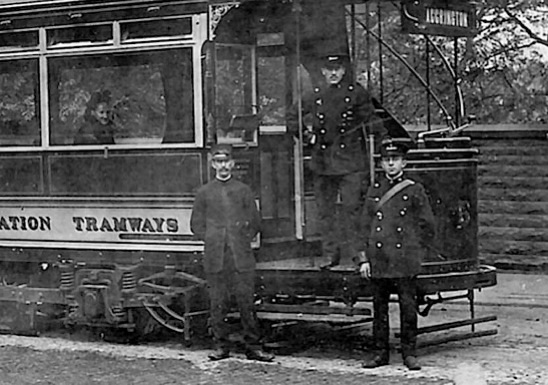
An inspector (left), very possibly the same man as in the preceding image, with the crew of Accrington-bound Tramcar No 5 — photo undated, but probably taken in 1907/8. Photo courtesy of Duncan Holden.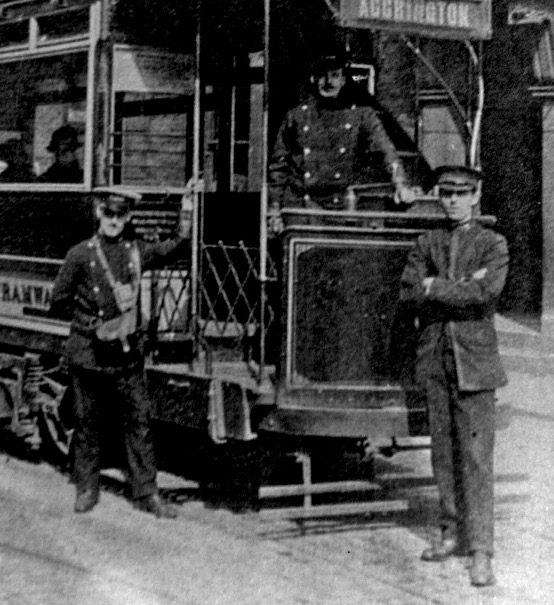
An inspector (with arms folded) stands with the crew of an Accrington-bound tramcar — photo undated, but probably taken in the 1920s. By this time, and probably from much earlier, inspectors' drooping-peak caps had been superseded by tensioned-crown peaked caps. Photo courtesy of Jim Halsall.
Female staff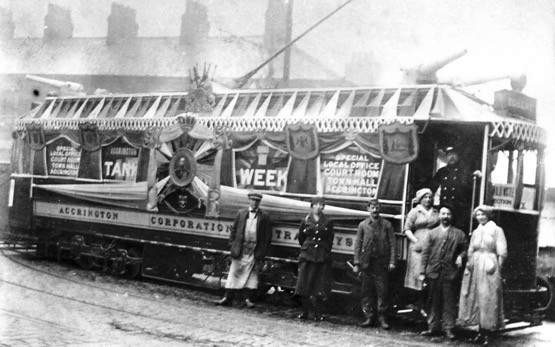
A poor quality image, but the only one I am so far aware of that shows a Great War tram conductress (second from the left). The photo can be fairly accurately dated to the week of the 28th January 1918, which was 'Tank Week' in Accrington and Blackburn, the tram being decorated to support the fund raising. Photo courtesy of Duncan Holden.